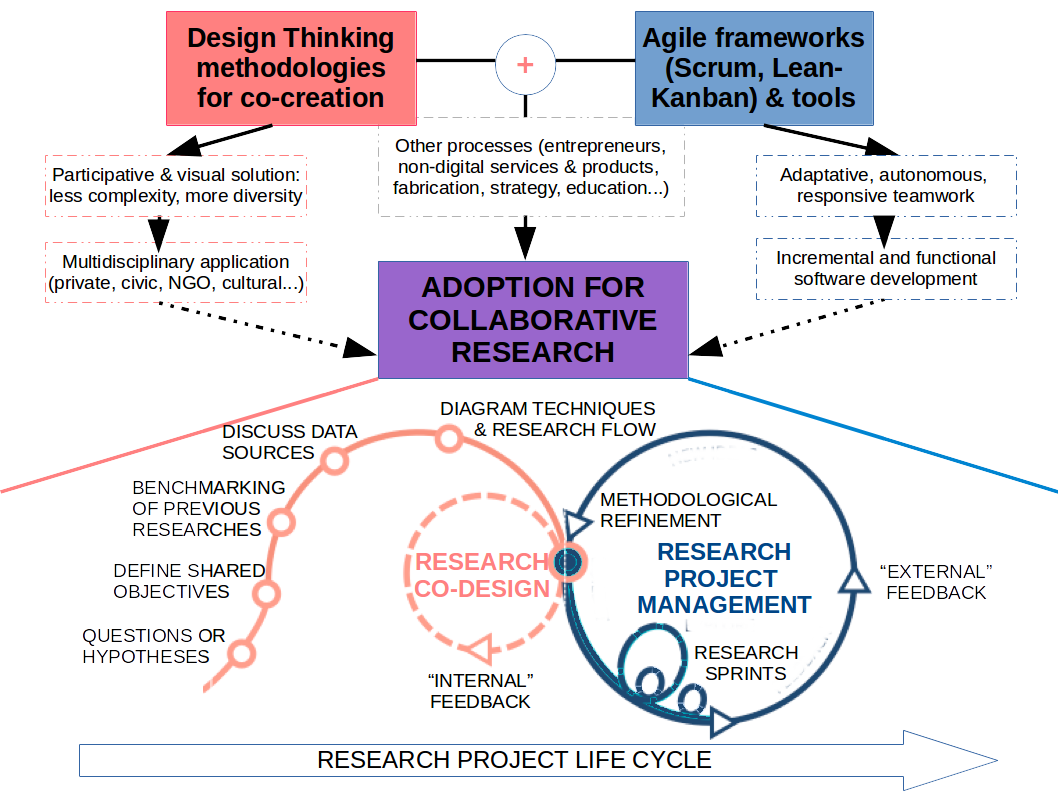Back to the blog, I’m currently part of the Dimmons research group at the Internet Interdisciplinary Institute, among other things dedicated to a PhD research with some “meta” implications: how two different methodological frameworks, Agile (from the practices of software development) and design thinking (as a wide paradigm of design methods connected to systems thinking), which were not originally developed in research contexts, can contribute to the regular tasks and dynamics of collaborative research practices. Specially for generating participative research ideation and design techniques (benefiting from diversity and co-creation) and for viable and useful alternatives in the project management of research processes (dealing with complexity in an effective way).
But what we really mean by “collaborative research” today? Isn’t the majority of research a collaborative effort, one way or another? From joint writing of proposals or co-authored papers, to online networks of peers and the spread of digital methods for data gathering, collaborating in science and research seems rather the norm (as opposed to the idea of a solitary scientist in the laboratory, that academic expert in an “ivory tower”). For example if we consider multi-authored articles, compared to single authorship ones, in journals of different academic fields since the 80s there’s an dramatic decrease in the number of sole-authored papers, and an incremental increase in articles written by two or more researchers (something, by the way, apparently connected to more quality results).

So first I’m trying to delimit a little bit more what “collaborative research” really implies, not only when it comes to co-writing, but also in terms of previous steps (like research design and planning, data gathering methods, or interpretation and dissemination of results). For that, I’m putting the focus on knowledge management for small-scale and large-scale team science, on the new and growing domain of citizen science, and on participative disciplines from social sciences, like action research or community-based research (constructivist approaches for collective inquiry projects and communities of practise, in order to do research “with” people rather than just “about” people).
Dynamic visualization of theories and relevant authors for collaborative research, Agile and design thinking, made with onodo
Then, two other explorations in parallel are needed. On the one hand, a closer look at how design (that “designerly way of doing“, in Nigel Cross words) has also a long tradition of dealing with research questions, wicked problems and reflexive-intuitive practices for collective action, for creating practical solutions based on shared challenges and evidences. Very close to the theoretical field of systems thinking, design thinking can be seen like an applied version of the same logics but with more human-based, visual and methodological sides (think about all those toolkits, canvas and “gamifications” for co-creation). There I’m specially interested in identifying existing and potential roles of co-design techniques for the conceptualisation, definition and planning of research processes, managing diversity of participants as “co-researchers”.
On the other hand, and also trying to distinguishing between documented, real applications and useless or overrated “business management fads”, I’m now looking at the theoretical foundations and practical uses of Agile, and how it helps to co-develop project management in complex settings. From the origins and wide application of Scrum, kanban or extreme programming in software development, to its current adoption outside that realm, in other fields and areas for developing products and services (with similar incremental logics, flexibility and making explicit the implicit at work). Apart from a solid set of practices and philosophy for teamwork, the Agile framework is rooted in the key concept of sharing tacit knowledge that Nonaka and Takeuchi described in the 80s (which connects somehow to the concept of reflective practice developed by Donald Schön). There has been already some experiences, studies and questions about the adoption of Scrum for research, but is still a type of methodological appropriation happening mainly “below the radars” and as far as I know not widely documented or analysed.
Project presentation (audio format) where I summarise its main goals.
After finding right now more connections in all this, between authors in fields like knowledge management, organisational learning, design methods, research philosophies and practices, system thinking, I’m growing a quite detailed set of sub-questions like…
- What is the researcher role of the facilitator or equivalent of Scrum master in all this, dealing with diversity and complexity?
- How both design thinking and Agile principles mean more participation in the inquiry process of not only expert researchers, but also laypersons or citizen scientists?
- What interfaces or instrumental implications has this on the possible adaptation of materials and toolkits for collaborative research?
- When or how there could be a digital dimension of some methods, for making them more distributed, and when things should stay offline and “local”?
- Which ways could work better for gathering data about the adoption of Agile and design thinking in collaborative research, comparing case studies or in more participative ways?
- …
So lots of collateral stuff!
